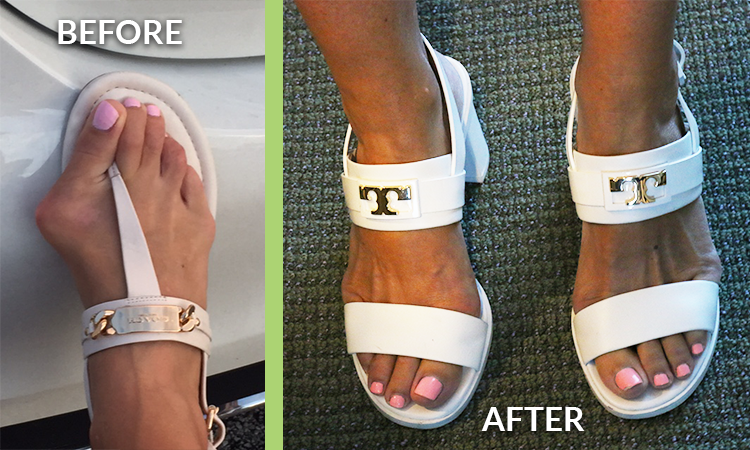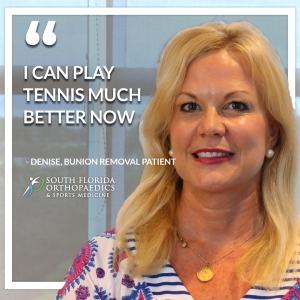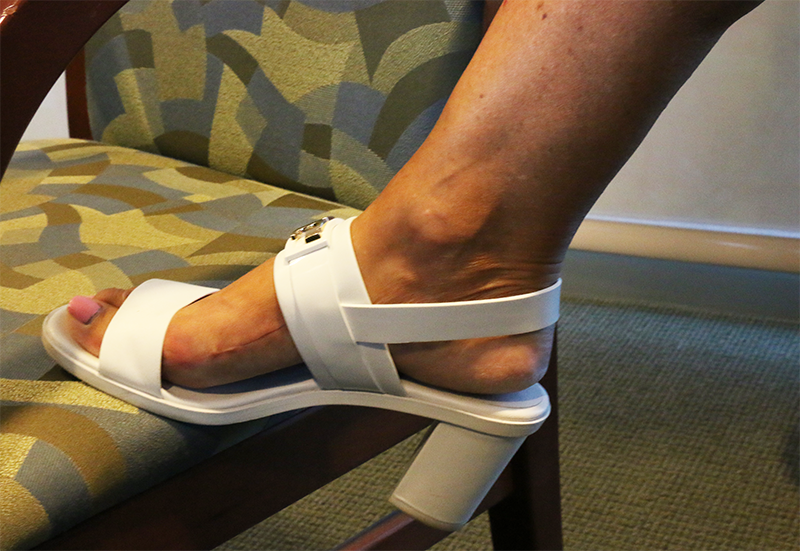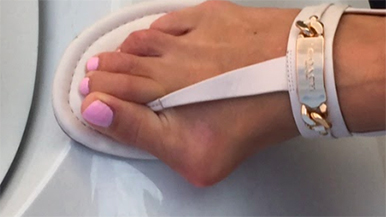- What Is a Bunion?
- How Are Bunions Treated?
- How Is Bunion Surgery Performed?
- What Is Recovery Like After Bunion Surgery?
The agonizing discomfort around Denise’s big toe joint got to the point where she could no longer wear the shoes she loved, had trouble walking without pain, and had to abandon one of her favorite sports, tennis. That’s when she decided to have bunion removal surgery.
To alleviate her symptoms and get back to normal functioning, Denise turned to Craig J. Breslauer, DPM, FACFAS, CWS, a podiatrist and board-certified in foot and ankle surgery at South Florida Orthopaedics & Sports Medicine. After more conservative options failed to relieve the pain, Denise and Dr. Breslauer decided that surgery would give her the best chance to walk pain-free again and to return to the activities she loves.“I had bunion surgery a year ago with Doctor Breslauer,” says Denise. “And, the biggest benefit is that now I can walk without pain, which is awesome.”What Is a Bunion?Contrary to what many people think, a bunion is not an abnormal growth at the base of the big toe. Known to doctors as hallux valgus, a bunion represents a structural shift in the foot where the big toe joint drifts toward the other toes. The change causes the metatarsal bone to protrude on the inside of the foot creating a bony lump or bunion.
Bunions are one of the most common structural deformities in podiatric medicine, with more than 150,000 bunion surgeries performed annually. Bunions are often hereditary particularly among people with low arches, flat feet, and stiff joints and tendons; they also tend to occur more often in women than men, typically resulting from years of abnormal motion and pressure on the joint due to high-heeled shoes. Research shows that up to 35% of adults over 65 have bunions.
As bunions get worse and alter the bony structure of the foot, one’s pain will increase progressively particularly when walking and may cause other problems like calluses, hammertoes, and ingrown nails. Untreated bunions can also lead to bursitis or arthritis.
Denise used to resort to unorthodox solutions to avoid excruciating pain while playing tennis. Not so following her surgery with Dr. Breslauer. “I had to splice a little hole in my tennis shoes where the mesh is,” says Denise. “I would take a knife and make a tiny hole so that it wouldn’t rub against my bunion. I haven’t played tennis in a while because the movement really hurt the way my bunion was, but I can play tennis much better now.”

How Are Bunions Treated?

Non-surgical approaches can slow bunion development and allow people to live more comfortably. For one, patients can ensure that they wear correctly fitting shoes that provide enough space for all the toes.
Other measures patients can take to alleviate bunion pain include:
- Maintaining a normal weight
- Protecting the bunion with over-the-counter moleskin, felt, or gel-filled pad
- Using a shoe insert, arch support, or other prescription orthotic device
- Sleeping with a splint to help straighten out the toe joint
- Taking non-steroidal anti-inflammatory medication such as ibuprofen
- Icing the bunion or soaking the foot in warm water
- Massage therapy
“One of my girlfriends in the neighborhood recommended Dr. Breslauer,” says Denise. “I came in for a consultation, and Dr. Breslauer shared with me that you have to be ready for surgery, and I asked, ‘well, is there anything that we can do in the interim?’ And we did a couple of steroid shots which helped some, but the pain was going up my ankle.”
When her bunion pain became too much to bear, Denise decided that surgery would give her the best chance for permanent relief. “I was having a difficult time even trying to exercise and go walking,” says Denise. “It got to the point where I had so much pain that I had to have it done.”
The decision to undergo surgery is never an easy one, and should only be done as a last line of defense. Critical for the patient in the process is choosing a surgeon that inspires confidence and with whom they feel comfortable. “What I like about Dr. Breslauer is that he’s very thorough,” says Denise. “He has a nice bedside manner. He’s not going to sit there, tell jokes, and try to be a comedian. He takes it very seriously and wants to be as precise as possible.”
“I also liked that he’s on a couple of different boards, and he does speaking engagements. He’s a leader in the community and within his profession. Knowing that made me feel more self-assured.” How Is a Bunion Removal Surgery Performed?Typically, bunion surgery involves amending the alignment of the bone and adjusting the soft tissues surrounding the big toe. Sometimes there is an imbalance in the tension between the tendons and ligaments on either side of the big toe that needs to be readjusted.
During bunion surgery, a foot and ankle surgeon will aim to:
- Realign the metatarsophalangeal (MTP) joint at the base of the big toe
- Relieve pain
- Correct the irregularity of the bones comprising the toe and foot
What Is Recovery Like After Bunion Removal Surgery?

Bunion surgery is generally a highly successful procedure with studies confirming patient success ratings of 85–90%. Each patient’s unique recovery trajectory will depend on their overall health, age, medical history, and the severity of their bunion deformity.
Patients often wear a surgical boot to protect the foot for the first couple of weeks after surgery. Afterward, they may wear a brace and need crutches until they can bear weight on the foot. Some inflammation in the foot is normal and can crop up from time to time for up to six months after the procedure. Most patients can expect to resume normal activities within two months after surgery.
Denise can now engage in her favorite activities again in the footwear of her choice. And judging by the feedback from those closest to her, she knows she made the right decision. “There were some shoes that I couldn’t wear because it would accentuate the bunion and hurt if it rubbed against it,” Denise says. “I can wear shoes that I wasn’t able to before.”
“When I show the before and after pictures to my friends and family, they’re like, ‘oh my gosh, Dr. Breslauer is brilliant, he’s amazing.’ A couple of people texted, ‘wow, he’s amazing.’ I’m very happy, not just from an aesthetic perspective but also physically I can run, walk, and do aerobics. I have two dogs I need to walk every day. So, it’s been great.”
Following her successful bunion surgery, Denise does not hesitate to endorse the surgeon who got her back on her feet. “Dr. Breslauer is awesome. I would recommend him to anybody.”
